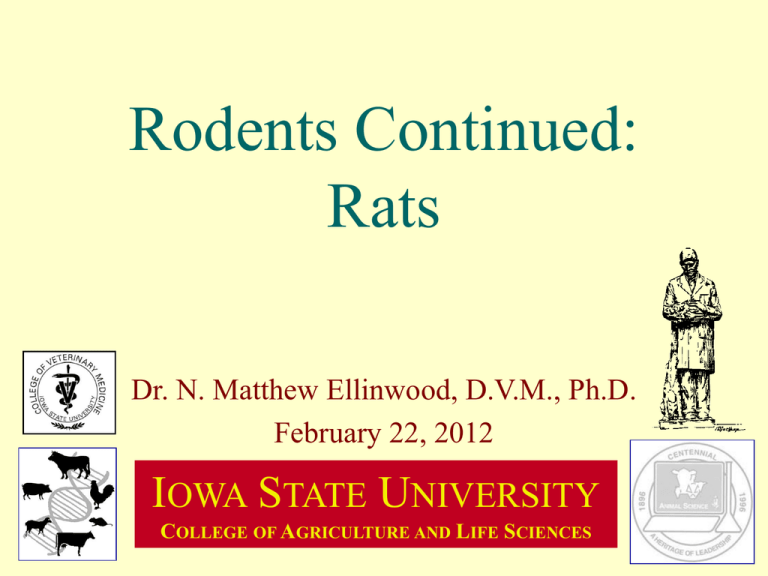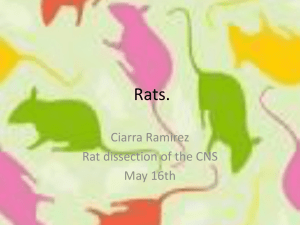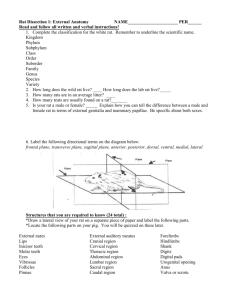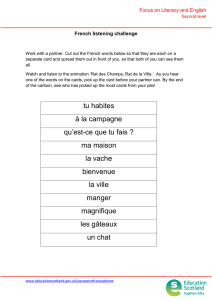Rodents Continued: Rats I S
advertisement

Rodents Continued: Rats Dr. N. Matthew Ellinwood, D.V.M., Ph.D. February 22, 2012 IOWA STATE UNIVERSITY COLLEGE OF AGRICULTURE AND LIFE SCIENCES Taxonomy •Kingdom: Animalia •Phylum: Chordata •Class: Mammalia •Order: Rodentia •Superfamily: Muroidea •Family: Muridae •Subfamily: Murinae •Genus: Rattus •Species: norvegicus (brown rat) Non-domestic “Brown Rat” • Rattus desiginates “true” rats or old world rats • Rattus norvegicus (city rat, sewer rat – also the black rat Rattus rattus): a domesticated opportunist • Other species of rats may act as opportunists in cities but are usually competitively replaced by the brown or black rat Rats in Popular Culture • Important figures in Indian and Chinese mythology • In western culture, almost uniformly a negative image • Perhaps associated with the Black Death – – – – – – Yersinia Pestis 30-60% of Europe's inhabitance 1348-1350 Mongols catapulting infected corpses Caffa, Crimea in 1347 Genoese traders took the plague to Sicily Origins • • • • Originated in China Spread to Europe New world in 1700s Now world wide Natural History • Life span: up to 3 years (extreme cases to 25 yr) • Sexual maturity: 65-110 days • Estrous; 4-5 days • Gestation is 21 days • Weaning; 3-4 weeks • Pups; 6-12 per litter • Tolerate group housing better than mice – Males assist with/tolerate nursing young Housing • Ease of housing/cleaning critical • Rodent chow, less than 6 months since milling • Slotted cage top feeder • Drip bottle water – Draining/drowning • Bedding changes – More frequent than mice • 30-70% Humidity • 65-85 oF Feeding • Rodent Chow • Coprophagic Anatomy • Rats lack a gall bladder • Harderian gland – Pigmented tears – Porphyrin staining Communication • Ultrasonic vocalization – Young • Elicits and directs maternal search behavior • Diminishes after 14 days old, especially around males – Adult • Response to predators or danger • frequency and duration of vary by sex/repro status • Females during mating • Chirping: short, high frequency, and ultrasonic – socially induced “laughing” at play, mating, and when tickled • Bruxing, or teeth-grinding – Triggered by well being and 'self-comforting' during stress – Clicking or 'burring' sound Fancy Variants • Rat and Mouse Club of America • American Fancy Rat and Mouse Association • Sendai virus and rat mortality Origin of Rat Fancy and Research • Rat baiting • Popular in Britain – Cruelty to Animals Act 1835 – 70 gambling rat pits • Suppliers began breeding and supplying as pets • Color variants started • Show placement in 1901 Variants • Siamese rat Hooded Rat American Blue Laboratory • Common Laboratory Rat Strains – Wistar rat: Albino white • Wistar Institute, Henry Donaldson, 1906, first rat biomed strain – Sprague Dawley rat: outcrossed albino, WI, 1925 – Long-Evans rat • Wistar and wild cross – outbred, behavior and obesity – Zucker rat • Lois M. and Theodore F. Zucker, obesity reseasrchers • Resecessive pbesity trait (leptin receptor polymorphism) Knockouts • Knockout rats exist but are far less common Diseases • • • • • Mammary tumors Obesity Ulcers over salivary gland Malocculusions Chronic respiratory disease – Multifactorial (m. pulmonis) • Bacterial pneumonia – S pneumoniae • Red eye GUINEA PIG MANAGEMENT Cavia porcellus Origin • • • • Cavia porcellus – domesticated Cavia aperia – wild wild – Peru, Argentina, Brazil, Uruguay also known as Cavies • domesticated 16th century – England Varieties of Guinea Pigs • Traditional American or English – short hair Abyssinian – whorls of short rough hair Peruvian – long hair Varieties of Guinea Pigs • New varieties Silky – medium length soft hair Teddy – short, coarse hair American Crested – short hair with contrasting whorl on forehead Rex – very short, soft hair Hairless Traditional varieties of guinea pigs American – short hair Abyssinian – whorls of short hair Peruvian – long hair New varieties of guinea pigs Silky – soft, medium hair Teddy – short, coarse hair American crested – contrasting whorl on head Rex – very short, soft hair Hairless – (well, almost) Basic Guinea Pig • compact stocky body • tailless • diurnal – actually short naps night and day • sebaceous marking glands - rump • open rooted teeth Additional characteristics • • • • • vocalize – at least 11 sounds good swimmers seldom jump rarely intentionally bite or scratch need frequent handling • lifespan – 5 yr average, ~8 yr max. Uses of Guinea Pigs • Pets • Scientific research • Food Home Sweet Home • Temperature: 70, 65 – 79 • Space < 350 gm 60 sq. in. > 350 gm 101 sq. in. max size 1.2 x 3.8 cm mesh or solid Home Sweet Home • Bedding wood shavings – not cedar, pine shredded paper not dusty timothy hay overlay optional clean weekly Home Sweet Home • Humidity 50%; 40 – 70 • Light cycle 12:12 • Air changes 10 – 15 per hour Digestive System • Strict herbivores • Hind gut fermenters – cecum Lactobacilli sp. primary fatty acid – propionic acid NUTRITION • require vitamin C • have higher folic acid requirement • sensitive to excess Ca, Vit. A, Vit. D leads to metastatic calcification mineralization of soft tissues Feeding • Additional Requirements ~ 6 gm feed/100 gm body weight 18-20 % protein 10-16 % crude fiber • Use guinea pig feed!!! • NOT RABBIT FEED no vit. C and high in vit. D Feeding Management • Messy feeders • Use J-feeders not bowl Water Management • Glass/clear bottles preferred • Like to play with waterers will empty water bottle and/or stop up the opening check frequently • Change & Clean water bottle daily • Automatic waterers check daily; acidify water at source reduces pseudomonas Water Management • Glass/clear bottles preferred • Like to play with waterers will empty water bottle and/or stop up the opening check frequently • Change & Clean water bottle daily • Automatic waterers check daily; acidify water at source reduces pseudomonas REPRODUCTION • age to sexual maturity 68-70 • estrous cycle 15-17 days • gestation 59-72 days SEXING male: straight slit female: Y-shaped SEXING male: straight slit SEXING female: Y-shaped BREEDING • females pair at 400gm; 2-3 months • males pair at 600 gm; 3-4 months • breed females before 6 months otherwise pubic symphysis fuses must relax at parturition Response to the hormone relaxin Guinea pig once used in bioassays for relaxin Care of Young • precocial – born furred, eyes open, teeth erupted walking within 2 hours • two nipples – inguinal region can care for four young litters 3-4 (range 1-6) Care of Young • milk 3.9% fat 8.1% protein 3.0% lactose DISEASES • • • • • genetic infectious environmental nutritional others DISEASES • malocclusion – over growth of teeth • causes environmental inadequate opportunity wear down teeth genetic teeth do not meet properly • in guinea pigs lower premolars may be tilted inward eventually tongue is trapped INFECTIOUS DISEASES • Bordetella bronchiseptica - pneumonia do not house with subclinical carriers rabbits, cats, dogs • other infectious diseases are much less common OTHER DISEASES • vitamin C deficiency – scurvy • metastatic calcification mineralization of soft tissues • heat stroke 85º F+, high humidity, lack of ventilation • barbering small bald patches Public Health Risks • minimal • diseases guinea pigs may carry Bordetella, Salmonella, Yersinia pseudotuberculosis, Streptococcus CHINCHILLA MANAGEMENT Chinchilla lanigera Origin • Two species in the wild – Chinchilla brevicaudata • Shorter, stockier, and facing extinction • A previously extant species is already extict – Chinchilla lanigera • Chinchilla lanigera – domesticated • wild – Peru, Argentina, Bolivia, Chile • Spanish discovered them in 16th century • Crespuscular – Active – require wheels • Names after the Chincha people of the Andes: “Little Chincha” • Hunting in the 19th century – Fur trade led to rarity in the wild • Rock crevices in the wild • Can jump up to 6 feet high • In the wild, groups called herds • Nonseasonally polyestrous • Gestation is 111 days – Usually two offsping – Precocial • Prey species defense – Fur release – Urine spraying • Dust baths – Fine volcanic dust (pumice) • Diet – Pelleted chinchilla with timothy hay • Raisin supplement 1-2 per day • Do not over supplement on fruits and vegetables Research Importance • Hearing – Range and anatomy • Chagas disease – Parasitic diseae causing American trypanosomiasis • Gastrointestinal disease • Listeriosis Colors of Chinchilla Standard Grey Ebony Homozygous beige Heterozygous beige Brown Velvet Black velvet Golden mosaic Sapphire Silver Silver white Albino white Pure white Degus South American rodent Related to Guinea pigs Smaller, social rodents







